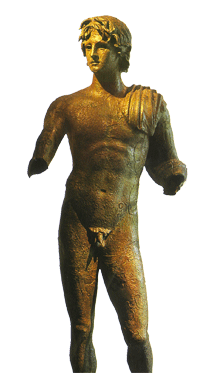The History of the Languedoc: Greeks and Phoenicians
In the Seventh century BC the Etruscans, masters of the
Mediterranean
Sea, established trading links with the Languedoc.
Great amphorae and ceramic potery known as "buccero
nero" are known from this period, and traces of the
Etruscans have been found at Bessan, Substanton (Catelnau-le-Lez)
and the port of Lattes.
|
  In
the following century, Greeks from Phocius (Phocée)
are known to have traded with the Languedoc. They
founded Massalia, (modern Marsielle) and then Agatha
(modern Agde),
both trading ports. They tended to keep to the littoral,
but Greek coins and pottery, including amphorae from
this period is known as far inland as Gaudevan. In
the following century, Greeks from Phocius (Phocée)
are known to have traded with the Languedoc. They
founded Massalia, (modern Marsielle) and then Agatha
(modern Agde),
both trading ports. They tended to keep to the littoral,
but Greek coins and pottery, including amphorae from
this period is known as far inland as Gaudevan.
It was the Greeks who introduced viniculture
to the Languedoc, so vines have been cultivated here
for two and a half milennia. Even in Greek times wine
was exported to to Gaul and Italy, while drinking
vessels were imported to the Languedoc.
  The
Languedoc also provided a trading gateway, for example
giving the Greeks access to tin from the Aquitaine. The
Languedoc also provided a trading gateway, for example
giving the Greeks access to tin from the Aquitaine.
Another characteristic feature of this period is
the oppidum, a hill-top town, similar to later bastides.
These towns were defensible and provided panoramic
views of land and sea. Examples may be seen at Enserune
(Hérault
département), Béziers,
Carcassonne,
Le Cluzel (near Toulouse),
and the mont Cavalier at Nîmes.
Around this time a few villages grew into sizeable
towns, with extensive use of dry stone walls.
Around the fifth century the Celts
arrived and settled in the Languedoc.
|
|
The Ephebe
of Agde (L'ehpebe d'Agde), a bronze statue,
1.4 m tall, dates from the second century
BC was discovered in the Heralt River in 1964.
Ephebos (often in the plural epheboi),
also anglicised as ephebe (plural: ephebi),
is a Greek word for an adolescent age group
or those belonginging to a social status reserved
for that age in Antiquity.
Though the word can refer to the adolescent
age of young men of training age, its main
use is for the members, exclusively from that
age group, of an official institution (ephebia)
that saw to building them into citizens, training
them as soldiers, sometimes already sent into
the field; the Greek city state (polis) mainly
depended, as the Roman republic before Marius's
reform, on its militia of citizens for defence.
|
|
|
|
|
|
 Back to the Celts. Back to the Celts.
|

|
Next Page: The Romans 
|
|
|








